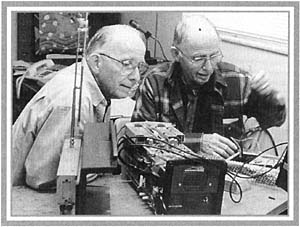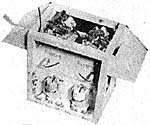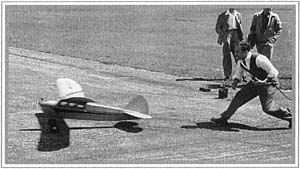
|
| In
Walt's shop in Florida, the 75-year-old Good twins work on
a spectrum analyzer that was built by Bill. |
Their historic R/C model airplane, which they affectionately
named the "Guff," was presented to the National Air and Space
Museum in Washington, D.C., in May, 1960, where it can be seen
today.
Both brothers continued their education and subsequently earned
doctorates in physics. After pursuing careers in electronics research
and teaching, they retired, but they're still very active in electronics.
Walt lives in Florida, and Bill resides in upstate New York. They
communicate constantly with each other using theiri ham radios.
JOSEPH
RASPANTE
No story on the early days of R/C would be complete without recognizing
the work of Joseph Raspante. Unlike most of the early pioneers
of WC, who were basically model airplane builders teamed up with
ham-radio specialists, Joe Raspante was a superb designer and
builder of early gas models as well as a competent electronic
technician. His R/C system was unique in that he used a telephone
dial to select various control functions. He placed second in
the 1939 R/C Nationals and third in the 1940 event. Raspante was
generous, and he shared his knowledge with young builders in years
that followed.
|
| |
Walter Good remembers that when thieves stole
his brother's R/C transmitter from their hotel the day before
the 1940 Nationals, Raspante offered the use of his own transmitter.
This gesture was especially meaningful, because the Good brothers
had defeated him in the 1939 Nationals.
Raspante finally won the first place he yearned for at the
1946 NY Daily Mirror contest at Grumman airfield. It was my
privilege to see him fly there. With the advent of the transistor
and the integrated microcircuits, today's R/C builder hardly
has any of the frustrations of the early pioneers. In retrospect,
however, we see that most of the pioneer's dedicated efforts
were largely foiled by overly complex electrical designs.
But without their perseverance, I doubt that R/C flight would
have progressed as quickly to where it is today.

The balsa frame that holds Guff's receivers- one
for the rudder and one for the elevator- is 6
inches high. It's total weight is 14 ounces (less
batteries. |
|

Joe
Raspante launches his R/C model at the 1946 NY Mirro Meet
at Grumman Airport ni Long Island, NY. |
|